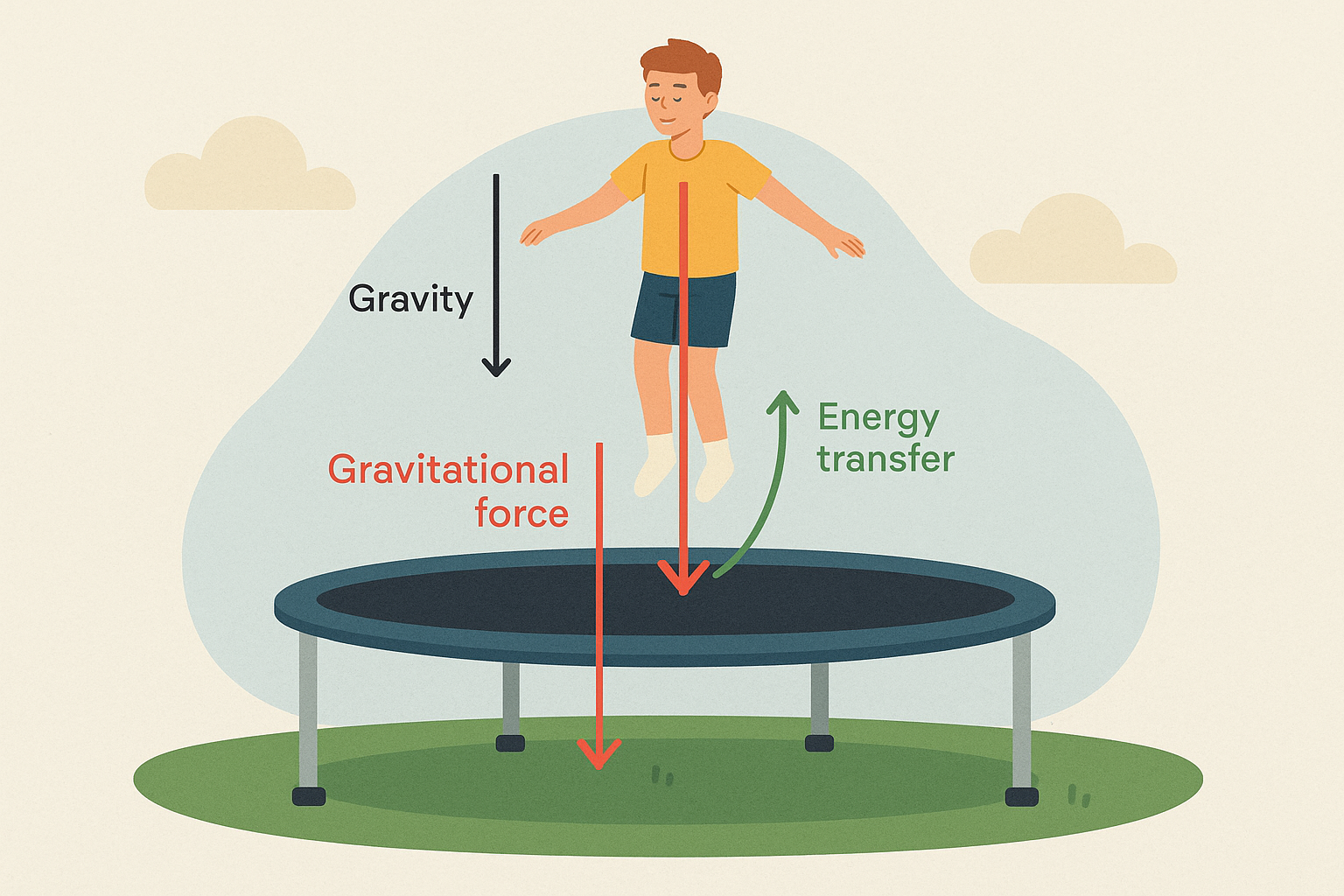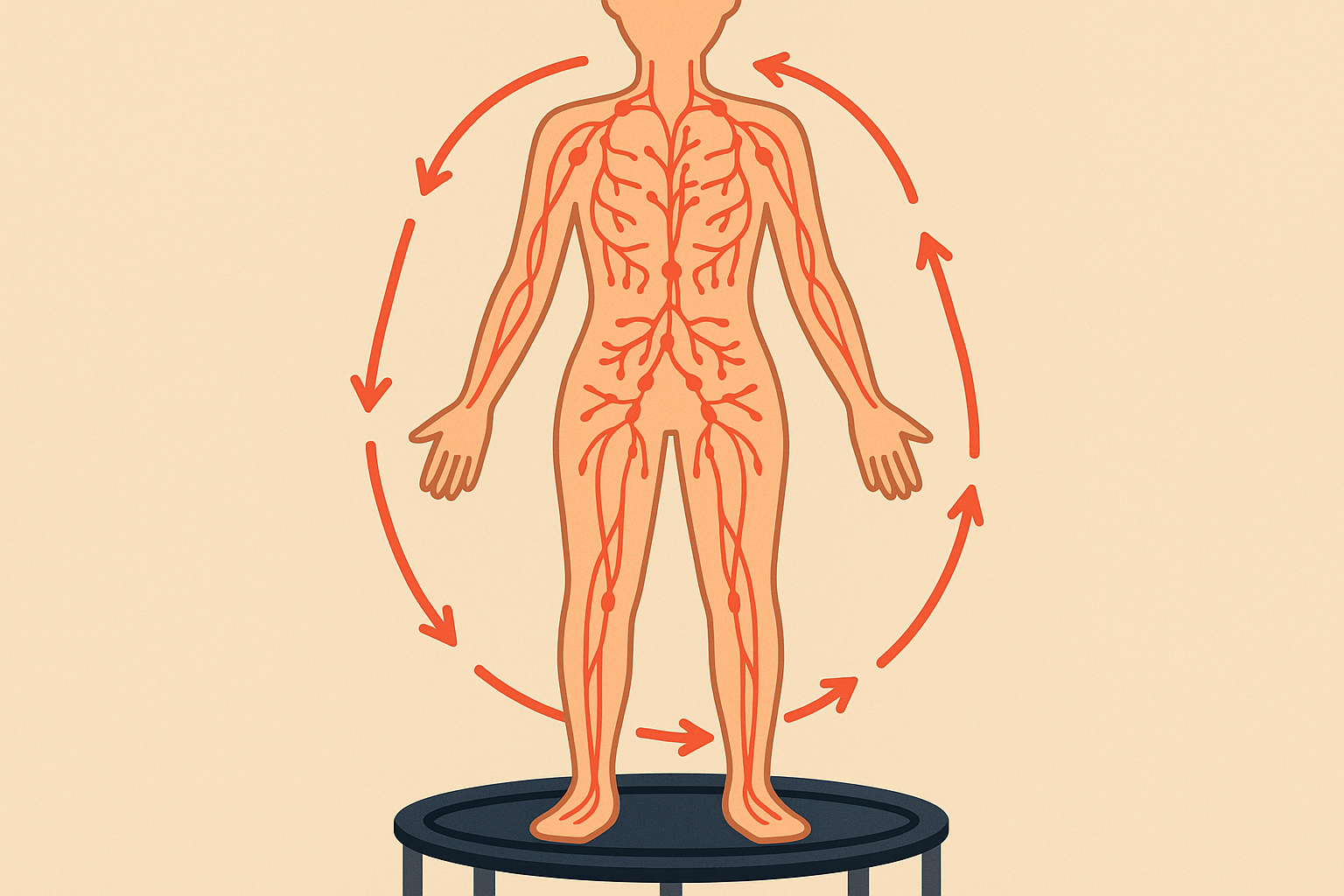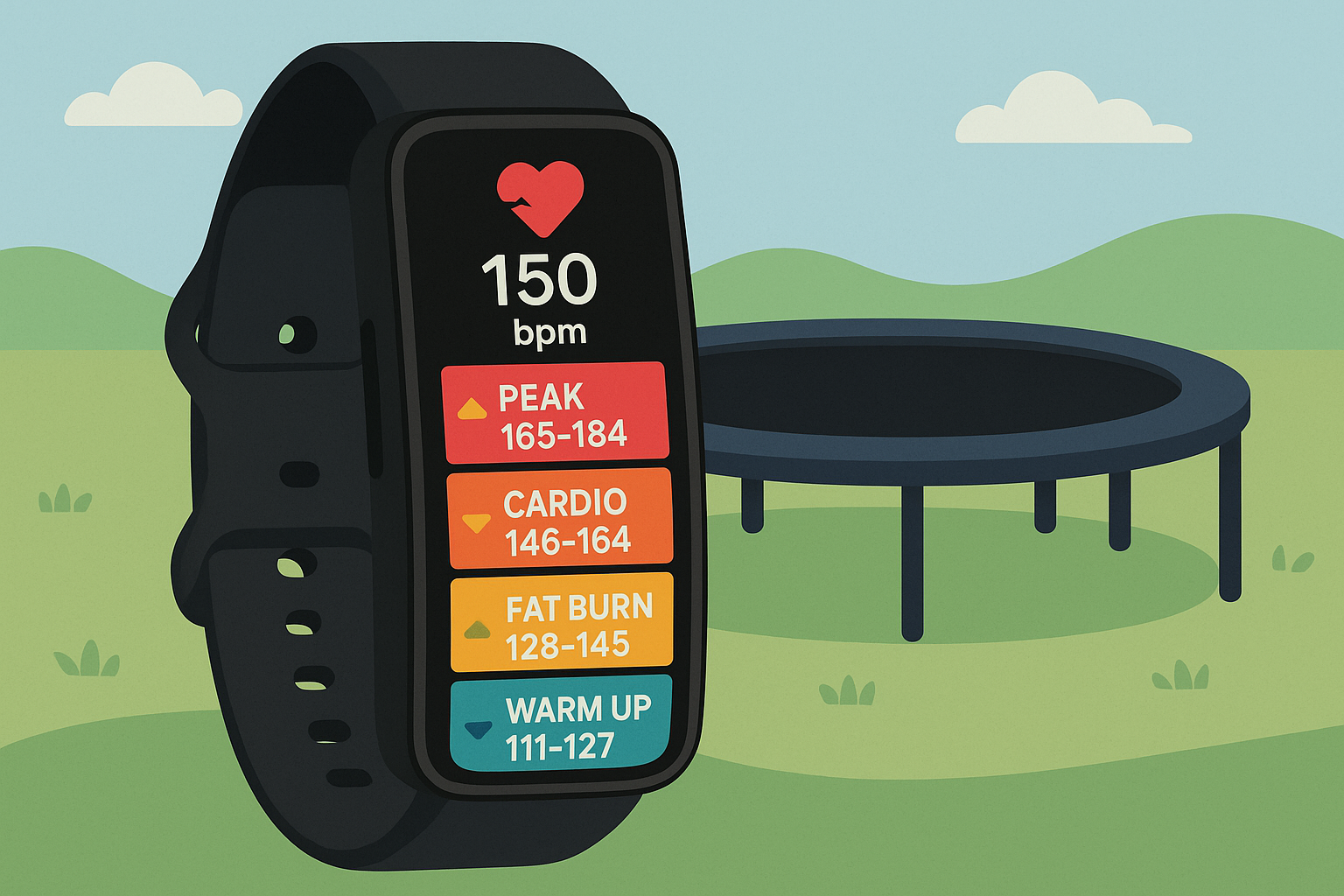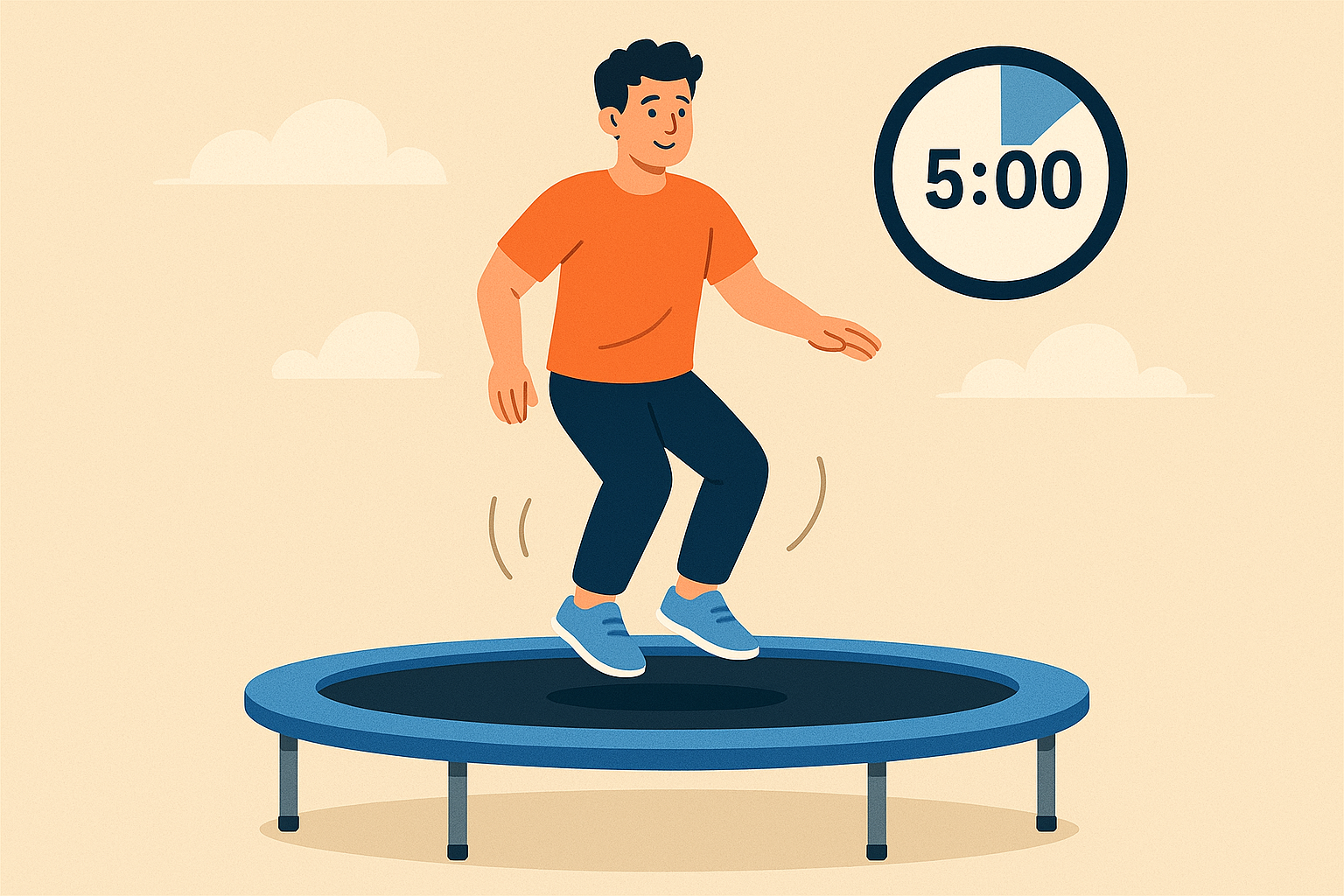
Okay, I’ll be honest – when my neighbor told me bouncing on a trampoline could burn as many calories as running, I thought she was nuts. But then I dug into the research and tried it myself, and wow… According to the American Council of Exercise, jumping on a trampoline for 20 minutes burns the same number of calories as running 6 mph (10 km/h) for the same amount of time. This incredible calorie-burning power makes trampolines one of the most effective (and fun) cardio workouts you can do at home.

Table of Contents
- The Real Science Behind Trampoline Calorie Torching
- Your Body’s Energy Systems Go Into Overdrive
- Why Your Brain Burns Extra Calories While Bouncing
- Timing Your Bounces for Maximum Metabolic Impact
- Measuring and Maximizing Your Calorie Burn
- Your Step-by-Step Trampoline Transformation Plan
TL;DR
- Trampolines create 3-4G forces that make your body work 2-3 times harder than regular jumping
- The wobbly surface forces your deep muscles to burn extra calories constantly
- Morning bouncing sessions before eating can boost fat burning by 20-30%
- Your brain burns serious calories learning new movement patterns while bouncing
- Gentle evening sessions improve sleep quality, which helps your body burn more calories overnight
- Start with 5-minute sessions and work up to 15 minutes for the best long-term results
The Real Science Behind Trampoline Calorie Torching
Here’s the thing – trampolines aren’t just fun, they’re metabolic powerhouses. The combination of fighting gravity, staying balanced on an unstable surface, and getting your lymphatic system pumping creates the perfect storm for burning calories like crazy.
Understanding how trampoline exercise works aligns perfectly with biohacking principles for optimal metabolic function, creating natural adaptations that supercharge your body’s energy systems.
Your Body Fights Gravity Like Never Before
Think about it – when you bounce, you go from feeling weightless at the top to having 3-4 times your normal weight pushing down when you land. Your body is basically doing gymnastics with gravity, and that takes serious energy.
The NASA Trampoline Study found that bouncing on a trampoline is 68% more effective than jogging and requires less effort. Yeah, NASA studied trampolines. That’s how effective they are.
The Upward Battle Against Physics
Every time you push up, your muscles have to overcome both gravity AND the springy resistance of the trampoline mat. It’s like doing a double workout with every single bounce. This dual resistance makes your body work 2-3 times harder than jumping on solid ground, turning every bounce into a mini calorie-burning explosion.
Landing Burns Serious Energy
When you come down, your entire body has to work fast to absorb and redirect all that impact force. This creates an energy spike that keeps burning calories even after you’ve stopped bouncing. It’s like getting bonus calorie burn for hours after your workout.
Research shows that the mat of a trampoline absorbs over 80% of the impact on your joints, which means your muscles can focus on the fun stuff – propelling you up and keeping you balanced – rather than just trying not to get injured.

Those Zero-Gravity Moments Reset Everything
That brief weightless moment at the top of each bounce? Your heart gets a quick breather while your stabilizing muscles work frantically to keep you upright. It’s like natural interval training that your body creates automatically, maximizing calorie burn without you having to think about it.
Your Balance System Becomes a Calorie-Burning Machine
The wobbly trampoline surface forces your body to make tiny balance adjustments constantly. These little corrections might not seem like much, but they engage deep muscles and brain pathways that burn extra calories through challenges most exercises completely ignore.
Deep Muscles Work Around the Clock
Your core muscles – the ones deep inside that you can’t even see – work continuously to keep your spine stable while you bounce. This creates a metabolic demand that regular cardio just can’t match, turning your core into a 24/7 calorie furnace.
My friend Sarah works at a desk all day (sound familiar?). She started with just 5 minutes of bouncing while watching Netflix. Within two weeks, she could hold a plank 30 seconds longer than before. Now she jokes that she’s addicted to her trampoline – but hey, there are worse addictions, right? The best part? She can actually feel her abs working for the first time in years.
Your Inner Ear Goes Into Overdrive
Constant changes in position challenge your balance system in ways that make your brain work overtime. All that neural processing burns additional energy that adds up significantly over time. You’re literally getting a brain workout while you bounce.
The Hidden Lymphatic Calorie Burn
The rhythmic up-and-down motion creates a pumping action that gets your lymphatic system moving like crazy. This enhanced circulation helps flush out the junk your body doesn’t need while increasing cellular metabolism – basically helping your cells work more efficiently and burn more energy.
This lymphatic boost works similarly to the detoxification benefits found in Epsom salt baths, creating a natural cleansing process that supports your body’s ability to burn calories efficiently.
Your Cells Work Harder to Clean House
Better lymphatic flow means your cells need more energy to process waste and eliminate toxins. This creates additional calorie burn that continues working long after you’ve finished bouncing, contributing to extended energy expenditure throughout the day.

Your Body’s Energy Systems Go Into Overdrive
Now, before you think this sounds too good to be true, let’s talk timing. When you bounce matters just as much as how you bounce, and understanding your body’s natural rhythms can seriously amplify your calorie burn.
Trampoline jumping works perfectly with intermittent fasting protocols, creating synergistic effects that maximize fat burning when you time it right.
Morning Sessions Unlock Fat-Burning Superpowers
You know how some people are all “I work out at 5 AM!” and you want to throw something at them? Well, they might be onto something, at least with trampolines.
Bouncing Before Breakfast Torches Stored Fat
Your body wakes up ready to burn fat – especially if you haven’t eaten yet. It’s like your metabolism is saying “Okay, what stored energy can we use today?” Morning trampoline sessions before breakfast can boost your fat burning by 20-30%. That’s like getting a bonus workout for free.
But here’s the thing – you don’t have to be a morning person to make this work. Even 10 AM counts as “morning” for your metabolism. Just don’t eat first.
| Time of Day | Fat Burning Rate | Energy Source | Optimal Duration |
|---|---|---|---|
| 6-9 AM (Fasted) | 100% baseline | Stored fat (80%) | 15-20 minutes |
| 10 AM-2 PM (Fed) | 70% baseline | Mixed fuel | 20-30 minutes |
| 3-6 PM | 85% baseline | Recent food (60%) | 25-35 minutes |
| 7-9 PM | 65% baseline | Recent meals | 10-15 minutes |
Evening Sessions Reset Your Body Clock
Evening bouncing is different but still amazing. Gentle bouncing before bed helps you sleep like a baby, and better sleep means better calorie burning overnight. Your body does a lot of repair work while you sleep, and that takes energy.
Plus, it’s a way better way to unwind than scrolling your phone for two hours. Just saying.
Better Sleep Equals Better Calorie Burn
When you sleep better thanks to evening bouncing, your body releases more growth hormone during deep sleep. This supports muscle recovery and keeps your metabolism elevated overnight, turning your sleep into an active calorie-burning period.

Why Your Brain Burns Extra Calories While Bouncing
Here’s something cool I discovered – your brain is working overtime when you’re bouncing, and that burns extra calories too. It’s like getting a workout for your body AND your mind at the same time.
You know that feeling when you first step on a trampoline and your brain goes “Wait, what’s happening here?” That confusion is actually your brain firing up all sorts of neural pathways it doesn’t normally use. And guess what? That takes energy – real, calorie-burning energy.
Even Shilpa Shetty (yeah, the Bollywood star) gets this. She recently shared her trampoline routine on Instagram, highlighting how “trampoline jumping is not just good for the body—it is also beneficial for the mind” according to HealthShots. Smart woman.
The brain benefits of trampolines work perfectly with mental fitness training approaches, creating a comprehensive workout that challenges both body and brain simultaneously.
Learning New Moves Costs Serious Energy
Every time you try a new move or even just work on staying balanced, your brain is basically going to school. Learning new stuff burns calories – it’s like your brain hitting the gym.
Think about when you first learned to ride a bike. Remember how exhausting that was, even though you weren’t going very far? Same thing here. Your brain is working hard to figure out this whole bouncing thing, and that effort shows up as extra calories burned.
Both Brain Halves Fire Simultaneously
The really cool part? When you do movements that make both sides of your brain work together (like bouncing while moving your arms in different directions), you’re basically giving your brain a serious workout. More brain work = more calories burned. It’s like a bonus on top of your regular workout.

Your Brain Consolidates Movement Patterns
The process of turning new movements into muscle memory requires significant neural energy. This contributes to post-exercise calorie burn as your brain works to consolidate all that motor learning during recovery periods.
Stress Gets a Reality Check
Here’s something I love about trampolines – they’re basically impossible to be grumpy on. Try it. I dare you to bounce and stay in a bad mood. It doesn’t work.
This isn’t just feel-good fluff either. When you’re having fun (actual fun, not gym-pretend-fun), your body releases the good hormones and dials down the stress ones. Less stress hormones means your body can actually focus on burning calories instead of storing them “just in case.”
Joy Triggers Better Hormone Release
The playfulness of bouncing triggers more efficient feel-good hormone release compared to traditional exercise. This potentially reduces stress-induced fat storage while keeping your mood and metabolism elevated throughout the day.
My friend Mark figured this out the hard way. He was doing these intense, miserable treadmill sessions every morning and felt terrible. Switched to 15 minutes of bouncing, and now his resting heart rate dropped by 8 BPM and he actually looks forward to working out. Turns out enjoying your exercise is actually better for you. Who knew?
Timing Your Bounces for Maximum Metabolic Impact
Let’s talk timing, because apparently when you bounce matters just as much as how you bounce. I know, I know – one more thing to think about. But this one’s actually pretty simple and can dramatically boost your results.
Optimizing your trampoline schedule works hand-in-hand with hormonal balance strategies, ensuring your workout timing supports rather than fights against your natural rhythms.
Pre-Workout Timing Checklist
Here’s a simple guide to make sure you’re bouncing at the right time:
- Check when you last ate (3+ hours before for maximum fat burn)
- How’s your energy? (don’t bounce when you’re exhausted)
- Did you sleep well last night?
- How much time do you have to recover afterward?
- What’s your stress level today?

Measuring and Maximizing Your Calorie Burn
Let’s be real about tracking this stuff. You don’t need to become a data scientist, but knowing if it’s working helps keep you motivated.
The Telegraph did some research and found that “a moderate trampoline workout can burn between 200–300 calories in 30 minutes” according to fitness experts. That’s pretty solid for something that feels like playing.
Finding Your Personal Sweet Spot
The key is finding your optimal bounce intensity by paying attention to how you feel, your heart rate, and how well you recover. This sweet spot maximizes calorie burn without beating up your system, ensuring you can keep bouncing consistently.
Understanding how trampolines burn calories effectively requires the same precision approach used in cellular optimization strategies, where timing and intensity create maximum benefits.
| Body Weight (lbs) | Easy Bouncing (cal/min) | Hard Bouncing (cal/min) | 30-Min Session Total |
|---|---|---|---|
| 120-140 | 4.2-4.9 | 5.4-6.3 | 126-189 calories |
| 141-160 | 4.9-5.6 | 6.3-7.2 | 147-216 calories |
| 161-180 | 5.6-6.3 | 7.2-8.1 | 168-243 calories |
| 181-200 | 6.3-7.0 | 8.1-9.0 | 189-270 calories |
Heart Rate Zones Made Simple
Trampolines let you adjust intensity super easily – just bounce higher or faster to increase your heart rate, or lower and slower to bring it down. No guesswork needed like with other cardio.
Your Body Tells You What’s Working
Here’s what I’ve learned: your body is smarter than any app. If you’re bouncing regularly and feeling good, you’re probably doing it right. If you’re exhausted all the time or dreading your sessions, dial it back.
Using simple metrics like morning heart rate and sleep quality helps you figure out the right intensity and duration. This approach maximizes calorie burn while supporting recovery so you can keep making progress consistently.

Seasonal Adjustments Keep You Burning
Your body’s needs change throughout the year based on daylight, temperature, and your natural activity levels. Adjusting your trampoline routine accordingly maintains consistent calorie burn efficiency year-round.
Your Step-by-Step Trampoline Transformation Plan
Alright, enough theory. Let’s get you actually bouncing with a plan that won’t overwhelm you or set you up for burnout.
Building Your Bouncing Foundation
The key to long-term success is starting ridiculously simple and building up gradually. Your body needs time to adapt to all these new movement patterns and energy demands.
Weeks 1-2: Just Get Started
Seriously, that’s it. Five minutes, three times a week. Put on a song you love and just bounce. Don’t worry about form or intensity or any of that. Just get comfortable with the feeling.
Your goals:
- Don’t fall off
- Have some fun
- Notice how you feel afterward
That’s literally it. No pressure, no perfect technique required.
Week 1-2 Beginner Protocol:
- 5-minute sessions, 3 times per week
- Focus on basic two-foot bouncing
- Pay attention to how your heart rate responds
- Track your energy levels after bouncing
- Notice any balance improvements

Weeks 3-6: Add Some Variety
Now you can start playing around. Try bouncing while moving your arms. Bounce forward and backward. Turn around (carefully!). The goal is to challenge yourself just a little bit more.
This is when it gets fun because you start feeling like you know what you’re doing. You might even catch yourself smiling while you bounce. That’s the goal.
My friend Lisa (a 28-year-old teacher) progressed from 5-minute basic bouncing to 12-minute sessions with arm movements and directional changes. By week 6, she was burning an additional 45 calories per session compared to her starting point, showing how progressive overload works with trampolines.
Weeks 7+: You’re a Bouncer Now
By now, you’ll probably have your own favorite moves and routines. Maybe you’re doing 15-20 minute sessions. Maybe you’ve figured out that you love morning bouncing or that evening sessions help you sleep better.
The point is, you’re not following someone else’s plan anymore – you’re doing what works for you.
Making Bouncing Part of Your Daily Life
Here’s the secret sauce: make it stupidly easy to do and actually fun. Keep your trampoline somewhere you’ll see it. Have a playlist ready. Maybe bounce while watching TV.
Some people do 3-minute bounce breaks during work. Others have made it their morning coffee ritual (bounce first, then coffee). Find what works for your life, not what works for Instagram.
Pre-Meal Energy Activation
Try 3-5 minutes of gentle bouncing before meals to get your digestive system ready and improve how your body uses nutrients. This supports the metabolic processes that keep your calorie burn elevated throughout the day.
Stress-Busting Mini Sessions
Use 2-3 minute trampoline breaks during high-stress periods to reset your nervous system and keep your metabolism flexible. This prevents stress from slowing down your calorie burn while adding up to significant energy expenditure over time.

Evening Wind-Down Bouncing
Try gentle 5-10 minute evening sessions with focused breathing to help your body transition from stressed to relaxed. This supports overnight recovery and metabolic optimization for better next-day performance.
Your daily integration can be as simple as:
- Morning: 5-15 minutes if you’re feeling it
- Lunch break: 3 minutes to reset your energy
- Stressful moment: 2 minutes of bouncing beats stress eating
- Evening: gentle bouncing while thinking about your day
The best workout is the one you actually do. And the best part about trampolines? They make it pretty hard to not have fun while you’re doing it.
Speaking of optimization and recovery, I’ve found that combining trampoline exercise with high-quality nutritional support creates incredible synergistic effects. Organic Authority’s carefully selected supplements and collagen products can enhance the lymphatic drainage benefits of bouncing while supporting your body’s natural detoxification processes. Their bioavailable nutrition approach mirrors how your body actually utilizes the unique benefits of trampoline exercise – it’s all about what your cells can actually use, not just what you consume.

Final Thoughts
Look, I get it. Another fitness trend, another “miracle” exercise. But here’s the thing – trampolines aren’t new, and the science behind why they work so well is solid. Your body really does work harder when it’s dealing with changing gravity and trying to stay balanced on an unstable surface.
What gets me excited about this research is how it validates what many of us instinctively feel – that bouncing just feels different. Your body responds to the unique combination of forces, balance challenges, and rhythmic movement in ways that create lasting benefits extending far beyond the actual exercise session.
More importantly, it’s sustainable because it doesn’t feel like punishment. When’s the last time you could say that about exercise?
The key isn’t just understanding the science, though. It’s implementing these insights systematically, starting with those foundational 5-minute sessions and building toward more complex routines that challenge your energy systems progressively. Your body adapts remarkably quickly to trampoline exercise, but only if you give it the structured progression it needs.
Remember that timing matters enormously. Those morning fasted sessions can genuinely increase your fat burning by 20-30%, while evening sessions set you up for better sleep and overnight recovery. The beauty lies in how flexible trampoline exercise becomes once you understand these principles – you can adjust intensity, duration, and timing to match your body’s needs on any given day.
Start small, be consistent, and give yourself permission to actually enjoy working out. Your body (and your inner kid) will thank you.

